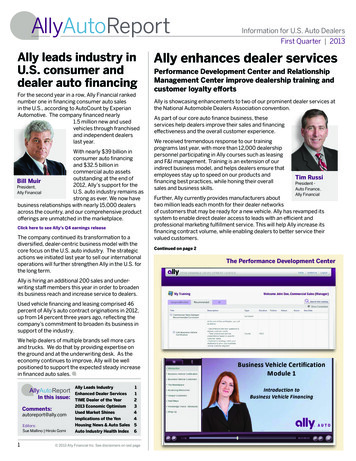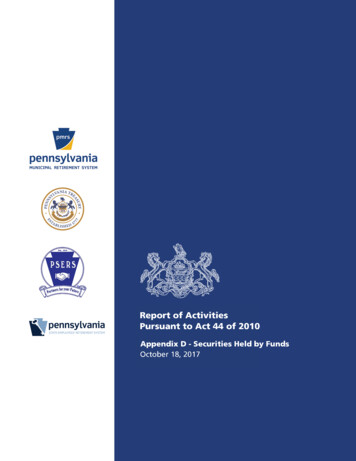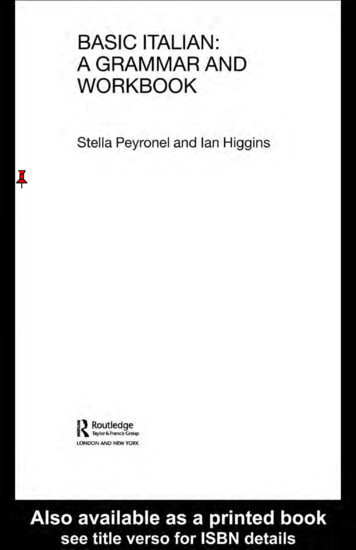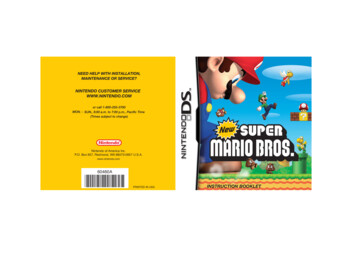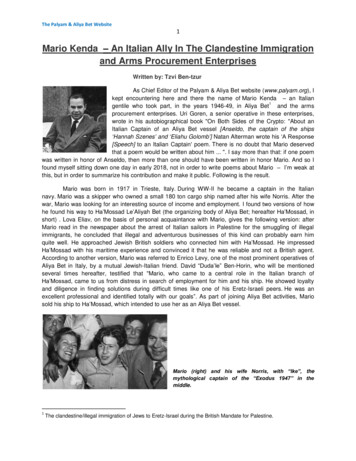
Transcription
The Palyam & Aliya Bet Website1Mario Kenda – An Italian Ally In The Clandestine Immigrationand Arms Procurement EnterprisesWritten by: Tzvi Ben-tzurAs Chief Editor of the Palyam & Aliya Bet website (www.palyam.org), Ikept encountering here and there the name of Mario Kenda – an Italian1gentile who took part, in the years 1946-49, in Aliya Bet and the armsprocurement enterprises. Uri Goren, a senior operative in these enterprises,wrote in his autobiographical book "On Both Sides of the Crypto: "About anItalian Captain of an Aliya Bet vessel [Anseldo, the captain of the ships‘Hannah Szenes’ and ‘Eliahu Golomb’] Natan Alterman wrote his ‘A Response[Speech] to an Italian Captain' poem. There is no doubt that Mario deservedthat a poem would be written about him . ". I say more than that: if one poemwas written in honor of Anseldo, then more than one should have been written in honor Mario. And so Ifound myself sitting down one day in early 2018, not in order to write poems about Mario – I’m weak atthis, but in order to summarize his contribution and make it public. Following is the result.Mario was born in 1917 in Trieste, Italy. During WW-II he became a captain in the Italiannavy. Mario was a skipper who owned a small 180 ton cargo ship named after his wife Norris. After thewar, Mario was looking for an interesting source of income and employment. I found two versions of howhe found his way to Ha’Mossad Le’Aliyah Bet (the organizing body of Aliya Bet; hereafter Ha’Mossad, inshort) . Lova Eliav, on the basis of personal acquaintance with Mario, gives the following version: afterMario read in the newspaper about the arrest of Italian sailors in Palestine for the smuggling of illegalimmigrants, he concluded that illegal and adventurous businesses of this kind can probably earn himquite well. He approached Jewish British soldiers who connected him with Ha’Mossad. He impressedHa’Mossad with his maritime experience and convinced it that he was reliable and not a British agent.According to another version, Mario was referred to Enrico Levy, one of the most prominent operatives ofAliya Bet in Italy, by a mutual Jewish-Italian friend. David “Duda’le” Ben-Horin, who will be mentionedseveral times hereafter, testified that "Mario, who came to a central role in the Italian branch ofHa’Mossad, came to us from distress in search of employment for him and his ship. He showed loyaltyand diligence in finding solutions during difficult times like one of his Eretz-Israeli peers. He was anexcellent professional and identified totally with our goals”. As part of joining Aliya Bet activities, Mariosold his ship to Ha’Mossad, which intended to use her as an Aliya Bet vessel.Mario (right) and his wife Norris, with “Ike”, themythological captain of the “Exodus 1947” in themiddle.1The clandestine/illegal immigration of Jews to Eretz-Israel during the British Mandate for Palestine.
The Palyam & Aliya Bet Website2The first significant activity he performed in the service of Ha’Mossad was to sail the Aliya Betvessel ‘Wingate’ to Eretz-Israel in the role of the ship’s captain. Mario knew the vessel very well - she wasthe ‘Norris’ that Ha’Mossad had purchased from him recently. On March 14, 1946, the ship departed froma small island in the Gulf of Venice called Palestrina, carrying 238 illegal immigrants on board. In additionto the Italian crew led by Mario, the ship was escorted by three Eretz-Israelis from Ha’Mossad, includingthe commander of the voyage David "Duda’le" Ben Horin, whose paths and those of Mario crossed morethan once. The Haganah prepared a major operation called "Wingate Night" to disembark the immigrantson the beach of Tel Aviv during the night of March 25-26. Many Haganah members were recruited for itand brought to Tel Aviv. But the plan was thwarted by the British who seized the ship at sea. OnePalmach fighter, a women named Bracha Fuld, was killed in clashes in Tel Aviv.‘Wingate’ is being intercepted by Britishdestroyers near the Israeli coastWingate was forced to sail to Haifa and all those who were on it were detained and transferred tothe Atlit detention camp (deportation to the detention camps in Cyprus started only in the summer of1946 until then, all were sent to Atlit). Among the arrested were Mario and the six Italians of hiscrew. Ha’Mossad made sure that they were released from detention shortly thereafter, at the expense ofthe monthly release quota, and housed them temporarily in an immigrant home in Binyamina.In addition to Mario and his crew, eight members of the Italian crew of the Aliya Bet vessel EnzoSereni, arrested in January 1946, were also stuck in Eretz-Israel. Ha’Mossad decided to lease a shipnamed Ada – a tiny vessel of 50 tons, equipped with an engine and a sail, owned by the Jew of Palestine– to return the Italian crews back to Italy and also to transport there six Ha’Mossad operatives, amongthem Lova Eliav, who was appointed commander of the trip.Mario was appointed by Lova to be in charge of all the Italians on the vessel. And so Lovadescribes Mario: "He was about thirty years old, average height, pony-haired and snub-nosed, with pinkcheeks and a round face that made him look younger than his years. Mario talked a lot, but he was not abore. And he knew his work very well". Those interested in the details of the journey can read about it inthe book "SS Ulua – The Story of Underground Aliya" by Lova Eliav. I’ll bring here just two episodes fromthis adventurous voyage. In the wake of a technical failure, the passengers of Ada were forced toabandon the vessel near the Turkish coast and move on to another small Turkish vessel. Love tried topersuade the Turkish captain to take them to Italy, but the Turkish captain refused to such unlicensedvoyage and the boat sailed to her home port in Bodrum, Turkey. In Bodrum, all the passengers wereplaced under house arrest (on board the boat), interrogated, and only the bribing of the Turkishauthorities, with a substantial payment to the owner of the ship, enabled the voyage to Italy to continue.Mario's advice was followed, and the boat arrived on May 19 in the small fishing port of the town of
The Palyam & Aliya Bet Website3Gallipoli. The reason that Mario specifically recommended Gallipoli was that he knew a brothel there thatcould serve as a hiding place. In Gallipoli, one of the more juicy anecdotes of Aliya Bet was originated –the story of the prostitute Lucia who hid the Eretz-Israeli at her home right after their illegal entry intoItaly. Mario and his Italian comrades – most of whom lack identification papers – were arrested,interrogated, and eventually released.The next time Mario's name is mentioned in connection with Aliya Bet was in October 1946, whenhe was appointed captain of the Aliya Bet vessel Bracha Fuld. The vessel – a small 500-ton freighter,originally named Fenice, purchased by the Ha’Mosad in Italy – was named after the late Palmach fighterBracha Fuld, who was killed by the British in Tel Aviv during the “Wingate Night” operation mentionedabove. Two of the vessel's escorts, the commander of the voyage Menachem "Churchill" Cohen and the‘Gideoni’ (radio operator) Haim Goldis, were well known to Mario – they were among his companions onthe arduous journey of the Ada. The vessel left Metaponto, southern Italy, on October 9, 1946, carrying626 immigrants, and on her way additional 180 immigrants came onboard via an auxiliary vessel ofHa’Mossad. Extremely rough sea coupled with technical engine failure caused panic among many of theimmigrants and the Italian crew members, but the resourcefulness of the Israeli escorts and CaptainMario saved the situation. The vessel was caught by the British on October 20 and was towed to the portof Haifa. The immigrants violently confronted the British and then they were deported to the detentioncamps Cyprus. Thus, at the end of October 1946, Mario found himself in British detention, for a secondtime in less than a year, this time in Cyprus.‘Bracha Fuld’ is being intercepted by theBritish near the Israeli coastMario was not the only Italian detained in Cyprus. In fact, he was in company there with othermembers of foreign crews of eight captured Aliya Bet vessels, comprising of Italians, French and Spanishexiles. As far as Ha’Mossad was concerned, this detention also had unfavorable economicconsequences, since it continued to pay the salaries of the detainees to their families on time. Ha’Mossadtherefore concluded that it had to smuggle the foreign crews back to Europe, and decided to smugglethem directly there, instead of transferring them to Eretz Israel first (using the monthly quota of releaseddetainees) and from there to their home countries. In early 1946, Yehuda Arazi, the head of the Italianbranch of Ha’Mossad, decided to use a 24-ton fishing boat named Dalin – the very same boad that "madehistory" back in August 1945 when she was the first Aliya Bet vessel to arrive in Eretz Israel after WorldWar II, marking the beginning of the golden age of Aliya Bet. The commander of the boat in the rescueoperation was David "Duda’le " Ben Hurin whom Mario knew well – Duda’le was his commander on theWingate voyage to Eretz Israel in March of that year. Dalin's voyage from Italy to Cyprus lasts nearlythree months (!) – a real odyssey in harsh winter seas. At the beginning of February 1947, Dalin finally
The Palyam & Aliya Bet Website4arrived at its destination in Cyprus. Twenty-one foreign crew members, including Mario, were smuggledout of the camps and assisted by a small boat that was overturned because of the weight of one of theItalians. The voyage back to Italy was short and lasted just a week. The boat entered in the evening to theport of Otranto, without bothering to contact the port officer who, in any case, cooperated withHa’Mossad. By five o'clock the next morning, all, including Mario, were on the train to Barry, and that wasthe end of the operation.After Mario's return to Italy, he joined the Italian branch of Ha’Mossad in the senior role of thebranch's Operations Manager. His responsibilities included purchasing vessels, preparing them to serveas Aliya Bet vessels, and recruiting local crew members to operate them. It should be understood that thepreparation of a vessel for clandestine immigration was a complex logistical-professional operation thatlasted several weeks (several months in the case of large ships such as the Exodus 1947): it wasnecessary to install bunks, toilets, kitchens, water tanks, etc., and to supply large quantities of food tohundreds of immigrants without endangering the safety of the ship.Immediately after the historic decision of the United Nations on November 29, Mario joined thecelebration of joy, as if he was an Eretz Israeli in every respect. Yehuda Ben-Tzur, a member of thePalyam (the maritime branch of the Palmach) who was involved in preparing an Aliya Bet vessel at theport of La Spezia, testified about the events that night: "One evening, after dark, I heard nervous horn’shonks of a car. I hurried to the deck and who do I see? Senior Ha’Mossad officers in Italy, Moshe “Zaki”Zakimovich, Shalom Assaf and Captain Mario Kenda climb up the gangplank, with the first swinging witha half-empty bottle in his hand and shouting "Yesh, Yesh” (in Hebrew: “We have it, We have it"). With sipsof wine from the bottle we celebrated the UN decision of November 29, 1947. On the spot, Zaki decidedthat we should also let Ben Yerushalmi have a sip, although he was preparing the vessel Christina Maria(later renamed "Lo Tafkhidunu” meaning: you won’t make us afraid) at Porto Stefano, about 350kilometers south of us. A report by Ben Yerushalmi came to me much later, in which he claims that by thetime we reached him at 3am, the bottle was already empty ”With the diminishing importance of clandestine immigration and the growing importance of armsprocurement, after the outbreak of the War of Independence, Mario found himself also involved in thearms procurement enterprise. The main operation in which his name was explicitly mentioned was "ThePirate" operation in August 1948. The following is a background of the operation. At the end of March1948, Shaul Avigur, head of Ha’Mossad and in charge of arms procurement in Europe, was informed ofan Italian vessel called Lino, carrying a shipment of 8,000 rifles intended for the Palestinians, that leftYugoslavia on its way to the port of Beirut. Shaul ordered the vessel to be stopped, and if possible to takepossession of its cargo. The vessel's entry for repair at a port near the port of Bari, Italy, provided anopportunity to drown it. The execution was carried out by a three-member Palyam squad that, on April 10,1948, succeeded in drowning the vessel in the waters of the port, without leaving any traces. The Arabsdid not despair and with assistance from the Italian Navy they retrieved the crates of rifles and theirammunition and prepared to re-dispatch them, this time to Alexandria, Egypt.Here begins "The Pirate" operation whose objective were to thwart the transfer of arms to theArabs and, if possible, divert the shipment to Israel. An operation’s planning team was established inBari, comprising of the two Israelis David "Duda’le" Ben Horin and Oved Sa’de, both were Palyamveterans, and the two Italians Mario and “Feinga” (nickname), a senior member of the Italian intelligenceservice who was loyal to Ha’Mossad. Mario bribed the Italian agent of the Arab representative in chargeof the cargo who was a major in the Syrian army, and the agent undertook in return to follow Mario'sinstructions. According to the planning team's instructions, the agent advised the Syrian to lease a vesselcalled Arjiro, to which Mario succeeded in infiltrating two loyal officers under the guise of a shipman and a
The Palyam & Aliya Bet Website5mechanic. Right after Arjiro sailed, a small fishing boat approached her and her captain was asked tostop. Duda’le and Oved then jumped onboard from the fishing boat, and while brandishing pistolsidentified themselves as Italian officers whose job it is to escort the vessel on behalf of her owners untilshe would safely reach her destination. The captain did not doubt the story and thus control waseffectively passed to the Israelis. On the way, ostensibly to Alexandria, they led the ship to a rendezvouswith the Israeli Navy corvette Wedgwood and Haganah. On August 28, 1948, the shipment arrived at theport of Haifa and the riffles were subsequently transferred to the IDF.‘Arjiro’ is being intercepted by twoIsrael Navy corvettesI believe that Mario, as part of his position in Ha’Mossad, was also involved in the purchase/leaseof vessels used in the arms procurement enterprise, but I have no references in support of this claim.Unfortunately, I have very little informationabout Mario after the end of the War ofIndependence. Itisknownthatasanacknowledgement for his contribution, the IsraeliDefense Ministry sold him for a third of the price, inJune 1949, the vessel Nora – the very vessel that"made history" when she brought the firstCzechoslovakian shipment of arms to Tel Aviv porton April 1, 1948, just in time to turn OperationNachshon into the turning point in the War ofIndependence. A letter written by Mario to ShaulAvigur in connection with the sale of the ship (hereon the left) indicates that Mario was on a mission onbehalf of Shoham – a subsidiary of Zim which wasestablished for the purpose of bringing immigrants toIsrael right after the State of Israel was establishedand a wave of mass immigration started – but I haveno details about the nature and scope of thismission.
The Palyam & Aliya Bet Website6I am certain that Mario's contribution to the clandestine immigration and arms procuremententerprises includes many more activities that are not mentioned here in the article and we will probablynever be known, lost in history. Unfortunately, I have no information about ties between Mario and Israelafter 1949. I do not know what happened to him, except that he is no longer alive. May his memory beblessed!I call on anyone in possession of additional information about Mario to pass it on to me andintegrate it into the article (I can be contacted via the Palyam & Aliya Bet Website, using the link:www.palyam.org/contact).
Italy. Mario and his Italian comrades - most of whom lack identification papers - were arrested, interrogated, and eventually released. The next time Mario's name is mentioned in connection with Aliya Bet was in October 1946, when he was appointed captain of the Aliya Bet vessel Bracha Fuld. The vessel - a small 500-ton freighter,
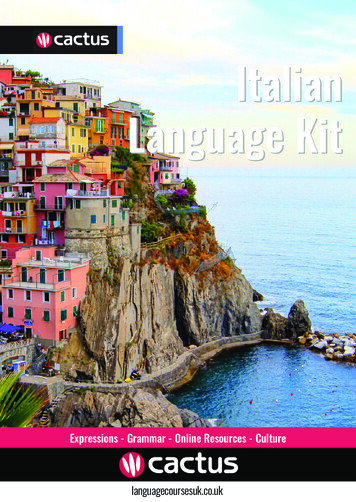
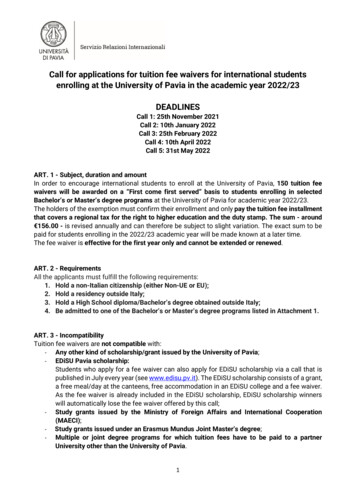
![Mendoza, Mario - Satan s [pdf]](/img/38/mariomendoza-satanas.jpg)

